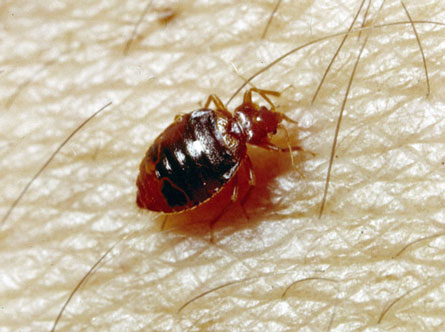INDIANAPOLIS — After trying some 50 arrangements of household objects, researchers have come up with a new low-cost, homemade bed-bug detector.

To lure the bugs out of hiding, Wan-Tien Tsai of Rutgers University in New Brunswick, N.J., put dry ice into an insulated, one-third-gallon jug, the kind available at sports or camping stores. Adding 2.5 pounds of dry ice pellets and not quite closing the pour hole allowed carbon dioxide to leak out at a bug-teasing rate for some 11 hours at room temperature, she said.
She stood the jug in a plastic cat food dish with a piece of paper taped on the outside of the dish as a ramp up to the rim. The bowl’s steep, slippery inside, with an added dusting of talcum powder, kept bugs from crawling out again.
In tests in real apartments, the homemade setup detected bed bugs as well, or better, than did two brands of professional exterminating equipment, Tsai said December 16 at the annual meeting of the Entomological Society of America.
The parts, including the dry ice, cost $15 and don’t require any special skills for assembly. “Everyone can do it,” she said.
These days a growing number of people might want to. The tiny, night-crawling bugs that draw blood and can leave itching welts had dwindled to rarity in North America during most of the last century. But since the 1990s, outbreaks have surged. The bugs flatten themselves into crevices in furniture, fabric and even electrical devices, and can prove difficult to eradicate. Many of today’s bed bugs are resistant to pyrethroid insecticides, which account for much of indoor pest treatments.
Tsai worked with Changlu Wang, also at Rutgers, for six months on designing homemade devices that lure bed bugs out into a trap so residents can tell whether a home is infested. Like many insects that search for blood, bed bugs are attracted to plumes of concentrated carbon dioxide, good clues that an animal filled with liquid dinner is breathing somewhere nearby. In lab tests, carbon dioxide beat heat and several chemical attractants in drawing the bugs out of hiding, Wang reported at the meeting.
He has published on low-tech ways to attract bed bugs with carbon dioxide. For example, setting out dry ice in insulated travel mugs can work. Apartment dwellers don’t need research supply companies for dry ice. Beverage companies, for example, may sell it by the pound.
To design a new low-tech detection system, Tsai experimented with various setups but says her breakthrough came when she discovered the one-third-gallon insulated jugs. They performed well in lab tests, so she decided to test them in apartments that had low levels of bed-bug infestation. She searched for bed bugs herself to confirm that apartments were suitable. Then she set either her homemade detector or a commercial one in each apartment near a typical bug haven, such as the sofa.
Designing and testing a low-cost detector is a substantial contribution to the field, comments entomologist Stephen Kells of the University of Minnesota in St. Paul. During decades of low bed-bug infestations, scientists didn’t study them much. “We have literally skipped a generation of knowledge with this pest,” he says.
Studies from early in the last century may not describe today’s bed-bugs well, says entomologist Andrea Polanco-Pinzón of Virginia Tech in Blacksburg. Older generations of bed bugs weren’t resistant to pesticides and lived in tougher environments: houses without central heating.
On the bright side though, Polanco-Pinzón reported at the meeting that her survival tests found that a pesticide-resistant strain she collected from Richmond, Va., lived at most two months without feeding. That record, set by the fifth stage of the immature bugs, falls far short of the year and a half reported in the old literature.






